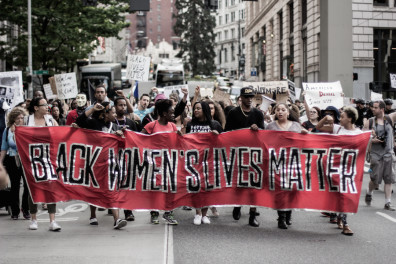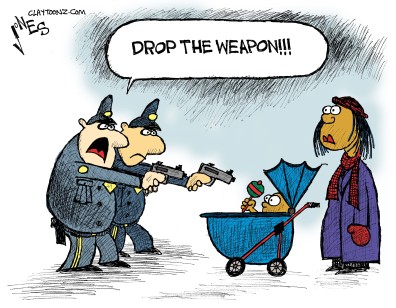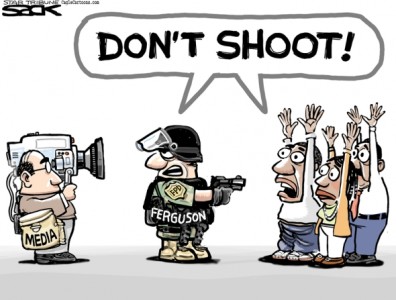Public Perceptions of Police Brutality in Post-Slavery America
christian.hardy
On the surface, incidences of police brutality may appear to be nothing more than trigger-happy and power hungry cops who give a bad reputation to an otherwise ethical and moral police force. In many respects, this statement is true. A few rotten apples often affect attitudes towards the entire barrel, yet many police officers care about their communities, want to do some good in those communities, and hold human life to the utmost importance. It is important to recognize, however, the racist and discriminatory tendencies riddled throughout the criminal justice system and substantiated in our law enforcement across the nation. Such tendencies are embedded in the United States from a long history of genocide, enslavement, and segregation committed by our ancestors and still felt to this day by those it affected. Racism, prejudice, and discrimination is still alive and well in a nation where we would love to forget about it. Unfortunately for them, it is perpetuated every day from media outlets portraying stereotypes of minorities, to our court system where minorities face discrimination at nearly every level of the court process including the prosecutor’s decision whether to charge and the sentence issued by the judge. The severe beating of Rodney King in 1991 by police officers in LA and the resulting LA riots would set into a motion a series of events that brought race to the forefront of the conversation regarding police brutality and misuse of force.
Police brutality is defined as using “excessive physical force or verbal assault” in the pursuance of a crime or the apprehension of an offender (1). Where deadly use of force crosses the line to police brutality is when the use of force exceeds that which is necessary to create a calm and safe environment. According to the Washington Post as of May 30th, 2015, there have been 385 fatal police shootings in so far in 2015 (2). Of those 385 victims, 27% were Black despite Blacks only representing around 14% of the total U.S. population (2). Whites, on the other hand, accounted for 46% of the victims while they represent around 63% of the total U.S. population (2). Blacks are, therefore, overrepresented as victims of fatal police shootings while Whites are underrepresented as victims of fatal police shootings. Furthermore, of the 62 victims who were unarmed when fatally shot, 66% of them were either Black or Hispanic (2). The more publicized incidences of police brutality and misuse of force have sparked a massive response from the public which has resulted in the formation of activist movements such as Black Lives Matter. These movements have made a huge impact on society’s understanding of why Blacks are disproportionately victimized by excessive use of force.
At the heart of the issue is underlying ideas of race including stereotypes we attribute to certain races that affect how we perceive the entirety of the group. Aggression and violence is typically applied to Blacks and is further perpetuated by media outlets such as music and television. Typical portrayals of African Americans as gangsters, drug dealers, and pimps as well as lyrics in rap and hip-hop music that promote violence contributes to society’s behaviors and attitudes towards Blacks. Such stereotypes culminate into the view of Blacks as the prototypical criminal (3). It is no wonder, then, that disproportionate numbers of Blacks are fatally shot by police as there is a greater perceived imminent threat regardless of whether they are armed with a weapon or not. Furthermore, the concept of “negro-phobia” is used to describe the fear of Blacks, specifically the fear of being victimized by Blacks (3). Tamir Rice serves as a prime example of negro-phobia.
Warning: May be graphic for some viewers.
- How does the Cleveland Police Department’s response to Tamir Rice after the 9-1-1 call reflect ideas of negro-phobia? Do you believe they were justified in their use of force? How could they have handled the situation differently, if at all, to avoid fatally shooting Tamir Rice?
- Where did these stereotypes of Blacks come from? Where did they originate from in United States history?
Several theories are utilized to explain perceptions of race and police brutality. Social Dominance Theory posits that Whites are the dominant group and, therefore, do not consider police brutality as serious when it disproportionately affects subordinate groups such as Blacks and Hispanics. Whites, then, tend to justify excessive use of force against Blacks, stating that they deserve harsh treatment because they shouldn’t resist arrest, shouldn’t wear “thug” or “gangster” clothes, and shouldn’t partake in drugs. Studies have reflected this theory, as 38% of Whites and 89% of Blacks view the criminal justice system as biased against Blacks, whereas 8% of Blacks and 56% of Whites saw the criminal justice system as treating Blacks fairly. What results is rewards such as promotions, rather than punishments, being given to police officers who commit these acts. Police officers are also exceedingly found not guilty of their charges if taken to court and acquitted with little to no hesitance despite strong evidence such as camcorder footage, witness testimony, and expert analysis being present. Eric Garner’s case involves the acquittal of a police officer charged with the murder of Garner despite overwhelming evidence at odds with the acquittal.
Warning: May be graphic for some viewers (fast-forward to 4:32 to arrive at the onset of the altercation although commentary at the beginning is important).
- Should Pantaleo, the NYPD police officer who applied the rear naked chokehold, have been found guilty? If so, what charge would you have given to him and why? If not, why do you believe it was the right decision for Pantaleo to be acquitted?
Social Impact Theory, on the other hand, studies situational factors that can augment attitudes towards misuse of force. Specifically, the number of shots fired and the number of officers present are tested to see if they have a positive or negative effect on perceptions of excessive use of force. Results showed that as the number of officers decreased and the number of shots increased, perceptions of excessive use of force were augmented (3) The Amadou Diallo and Michael Brown shootings are cases in which a high number of shots were fired with relatively few officers present at the crime scene.
- Which theory do you believe affects society’s perceptions of police brutality the most? What other theories/factors play a role?
As mentioned previously, not all police officers are bad and a very small portion of police officers are making headlines for excessive use of force. Law enforcement should be commended for their duty to protect and serve their communities in an ethical and moral manner. Racism and discrimination embedded in the criminal justice system, however, should not be ignored and thought of as nonexistent.
References:
(1) Chaney, C., & Robertson, R. V. (2013). “Racism and Police Brutality in America.” Journal of African American Studies. 17(3): 480-505. Online.
(2) Kindy, K. (2015). “Fatal police shootings in 2015 approaching 400 nationwide.” Washington Post. Online.
(3) Perkins, J. E., & Bourgeois, M. J. (2006). “Perceptions of Police Use of Deadly Force.” Journal of Applied Social Psychology. 36(1):161-177. Online.
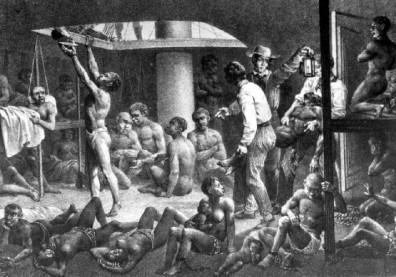
 In the year 1997, two heavily armed men entered a Southern California bank and began their reign of terror. Armed with automatic weapons, body armor, and ski masks, the two individuals forced their way into the bank and created a chaotic scene in order to get their money. As Los Angeles Police Officers responded, many of them were outgunned as they didn’t have the proper resistance (weaponry) to take on the suspects at large and protect the civilians around them (Orlov, 2012). With responding patrol officers only armed with semi-automatic rifles and 12 gauge shotguns, they were for a long time losing the battle that ended in dozens of officers and civilians injured. From this day that put all of North Hollywood, California in panic mode, police departments started providing semi-automatic rifles (M-16’s) to patrol officers, as well as increasing their use of Special Weapons and Tactics Teams (SWAT) (Orlov, 2012). This sense of ramping up increases in military like models has somewhat divided the country regarding whether to militarize our nations police forces or to demilitarize them. Some argue that equipping police across the country with military graded equipment leads to a totalitarian state with too much power and control of the government/ authorities, while others argue that equipping our police force with whatever they need is essential for the safety and protection of our communities; especially faced with an ever changing threat from those who wish to cause harm to civilians. Despite the appropriate increase of militarization to the combat criminals who pose as lot of risk, paramilitary group been seen to cause a lot of harm with their aggressive tactics; often leading to frustration within the community they are meant to serve. Thus, the militarization of police should not be used immediately, but rather only be used in dire situations.
In the year 1997, two heavily armed men entered a Southern California bank and began their reign of terror. Armed with automatic weapons, body armor, and ski masks, the two individuals forced their way into the bank and created a chaotic scene in order to get their money. As Los Angeles Police Officers responded, many of them were outgunned as they didn’t have the proper resistance (weaponry) to take on the suspects at large and protect the civilians around them (Orlov, 2012). With responding patrol officers only armed with semi-automatic rifles and 12 gauge shotguns, they were for a long time losing the battle that ended in dozens of officers and civilians injured. From this day that put all of North Hollywood, California in panic mode, police departments started providing semi-automatic rifles (M-16’s) to patrol officers, as well as increasing their use of Special Weapons and Tactics Teams (SWAT) (Orlov, 2012). This sense of ramping up increases in military like models has somewhat divided the country regarding whether to militarize our nations police forces or to demilitarize them. Some argue that equipping police across the country with military graded equipment leads to a totalitarian state with too much power and control of the government/ authorities, while others argue that equipping our police force with whatever they need is essential for the safety and protection of our communities; especially faced with an ever changing threat from those who wish to cause harm to civilians. Despite the appropriate increase of militarization to the combat criminals who pose as lot of risk, paramilitary group been seen to cause a lot of harm with their aggressive tactics; often leading to frustration within the community they are meant to serve. Thus, the militarization of police should not be used immediately, but rather only be used in dire situations. Ever since the Drug War era and the War on Terror, America’s law enforcement agencies have ramped up militaristic approaches and have led to a warrior ethos philosophy for officers. With a moral panic spreading across cities looking to put a stop to the selling and use of illicit drugs, the government stepped up its funding towards law enforcement hoping to create a deterrence. With many of these law enforcement agencies stepping up its presence in communities across the country, they created more specialized units; trained to handle the problems with strict guidelines of power and enforcement. The Drug Enforcement Agency and many other federal and local agencies put more funding and focus towards units that would rely on a forceful tactic of element and surprise to counter-act crimes (mostly dealing with drug offenses). These specialized unites (SWAT) would often force their way into homes (with body armor, assault rifles, flash-bangs, and a determined mindset to ravage these houses) of suspected drug users and dealers. More communities across the country (mostly poor minority communities) are experiencing heavily armed SWAT teams raiding people’s homes in the middle of the night, often just to search for drugs (ACLU). These police officer’s mindsets of a warrior mentality are often linked with the governments philosophy of “tough on crime.” However, for a lot of these cases the offender didn’t even present a violent offense. Last year (nationwide) police arrested 1.6 million nonviolent drug offenders (Stamper, 2011). Some of these non-violent drug offenders were taken into custody from SWAT teams assaulting their homes. The mere fact that these people presented no danger (based on intelligence gathering) make these dramatic invasions of the home unnecessary, as well as creates a traumatic experience for the people inside. In very shocking cases of SWAT team raids gone wrong, communities see that wrong houses are hit, as well as innocent people and family pets are shot and killed by the police raiding the homes. (Stamper, 2015). Problems like these where you have non violent offenders facing up against heavily armed men breaking down their doors, along with innocent people/pets getting killed creates an image of a public-safety institution (the authorities/police) at war with it’s own people.
Ever since the Drug War era and the War on Terror, America’s law enforcement agencies have ramped up militaristic approaches and have led to a warrior ethos philosophy for officers. With a moral panic spreading across cities looking to put a stop to the selling and use of illicit drugs, the government stepped up its funding towards law enforcement hoping to create a deterrence. With many of these law enforcement agencies stepping up its presence in communities across the country, they created more specialized units; trained to handle the problems with strict guidelines of power and enforcement. The Drug Enforcement Agency and many other federal and local agencies put more funding and focus towards units that would rely on a forceful tactic of element and surprise to counter-act crimes (mostly dealing with drug offenses). These specialized unites (SWAT) would often force their way into homes (with body armor, assault rifles, flash-bangs, and a determined mindset to ravage these houses) of suspected drug users and dealers. More communities across the country (mostly poor minority communities) are experiencing heavily armed SWAT teams raiding people’s homes in the middle of the night, often just to search for drugs (ACLU). These police officer’s mindsets of a warrior mentality are often linked with the governments philosophy of “tough on crime.” However, for a lot of these cases the offender didn’t even present a violent offense. Last year (nationwide) police arrested 1.6 million nonviolent drug offenders (Stamper, 2011). Some of these non-violent drug offenders were taken into custody from SWAT teams assaulting their homes. The mere fact that these people presented no danger (based on intelligence gathering) make these dramatic invasions of the home unnecessary, as well as creates a traumatic experience for the people inside. In very shocking cases of SWAT team raids gone wrong, communities see that wrong houses are hit, as well as innocent people and family pets are shot and killed by the police raiding the homes. (Stamper, 2015). Problems like these where you have non violent offenders facing up against heavily armed men breaking down their doors, along with innocent people/pets getting killed creates an image of a public-safety institution (the authorities/police) at war with it’s own people.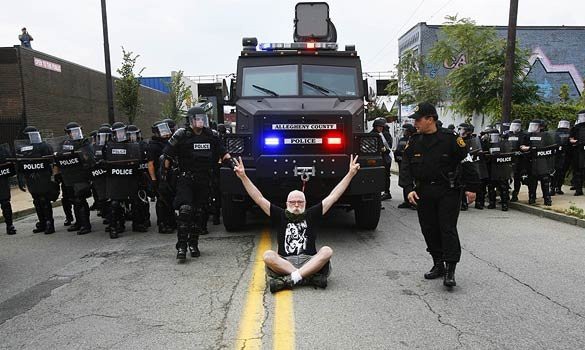 The year 1997 also brought along an updated program, known as the 1033 program (created under the National Defense Authorization Act). This program essentially allowed for the United States Department of Defense to transfer military-grade gear to civilian law enforcement agencies across the country because of the Iraq and Afghanistan war winding down. Through this program, agencies (including ferguson-area authorities) were able to acquire heavy body armor, semi-automatic rifles, armored vehicles (MRAPS and BearCats), grenade launchers, riot gear, tear gas, wet weather gear, and blankets (Fox & Cook, 2014). Through this increase in military style equipment, law enforcement agencies starting using them on a daily basis in order to maintain law and order on city streets. Even though officers use a lot of the equipment for their own safety (officer safety), they have been seen to use it incorrectly and inappropriately. As the Ferguson events were unfolding, the whole area had been on high alert which prompted authorities to shown in force. However, the only problem was many of the protests at the beginning were peaceful and really only needed a uniformed police presence (without the military gear and warrior mindset) to monitor their constitutional rights of free speech, as well as the right to assemble peacefully. After this chaotic scene of what seemed like the people vs. the police, the Department of Justice released their report on the Ferguson Police Department. The DOJ expressed that the police agency had handled the situation in the wrong manner (Reilly, 2015). They described that scene where police snipers were on top of armored vehicles, pointing their weapons at the crowds of peaceful protesters (Reilly, 2015). Many in the community saw these officers as attempting to intimidate and threaten the public they are meant to serve (Reilly, 2015). It’s very hard to understand that the men and women who swore to protect and serve are the same one’s seen on images and video’s already in confrontational tactical positions, as if they are ready to strike protesters (who want to freely express their opinions so that society can advance) at a moments notice. Police are meant to diffuse situations and have taken on the role of solving problems that get in the way of peace. However, recently in our history we have seen those in police uniforms escalating confrontations with their equipment, tactics, and demeanor (Baker, 2011). By playing the role of a warrior in the streets, it really hinders the chance to build ties with the communities they are meant to serve.
The year 1997 also brought along an updated program, known as the 1033 program (created under the National Defense Authorization Act). This program essentially allowed for the United States Department of Defense to transfer military-grade gear to civilian law enforcement agencies across the country because of the Iraq and Afghanistan war winding down. Through this program, agencies (including ferguson-area authorities) were able to acquire heavy body armor, semi-automatic rifles, armored vehicles (MRAPS and BearCats), grenade launchers, riot gear, tear gas, wet weather gear, and blankets (Fox & Cook, 2014). Through this increase in military style equipment, law enforcement agencies starting using them on a daily basis in order to maintain law and order on city streets. Even though officers use a lot of the equipment for their own safety (officer safety), they have been seen to use it incorrectly and inappropriately. As the Ferguson events were unfolding, the whole area had been on high alert which prompted authorities to shown in force. However, the only problem was many of the protests at the beginning were peaceful and really only needed a uniformed police presence (without the military gear and warrior mindset) to monitor their constitutional rights of free speech, as well as the right to assemble peacefully. After this chaotic scene of what seemed like the people vs. the police, the Department of Justice released their report on the Ferguson Police Department. The DOJ expressed that the police agency had handled the situation in the wrong manner (Reilly, 2015). They described that scene where police snipers were on top of armored vehicles, pointing their weapons at the crowds of peaceful protesters (Reilly, 2015). Many in the community saw these officers as attempting to intimidate and threaten the public they are meant to serve (Reilly, 2015). It’s very hard to understand that the men and women who swore to protect and serve are the same one’s seen on images and video’s already in confrontational tactical positions, as if they are ready to strike protesters (who want to freely express their opinions so that society can advance) at a moments notice. Police are meant to diffuse situations and have taken on the role of solving problems that get in the way of peace. However, recently in our history we have seen those in police uniforms escalating confrontations with their equipment, tactics, and demeanor (Baker, 2011). By playing the role of a warrior in the streets, it really hinders the chance to build ties with the communities they are meant to serve.
